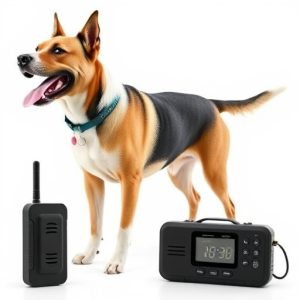Electronic Barking Dog Alarms: Benefits, Features, and How They Work
Electronic barking dog alarms provide a humane, technology-driven solution for managing nuisance bar…….
Electronic barking dog alarms provide a humane, technology-driven solution for managing nuisance barking. Combining sensors, amplifiers, and loudspeakers, these devices detect and respond to canine vocalizations through sound or ultrasonic waves, deterring excessive barking without harming pets. Customizable sensitivity levels minimize false triggers, and when paired with training, they promote responsible pet ownership. Key features to consider include adjustable sensitivity, training modes, sufficient range, and weather resistance for effective and durable outdoor use.
“Unleash the power of a silent guardian with an Electronic Barking Dog Alarm—a innovative solution for pet owners seeking effective, non-violent deterrents. This comprehensive guide delves into the inner workings of these devices, exploring their numerous advantages in training and safeguarding your furry companions. From detecting unwanted intruders to teaching obedience, we’ll navigate the key features to consider when selecting the perfect fit. Discover how an electronic barking alarm can transform your peace of mind.”
Understanding Electronic Barking Dog Alarms: How They Work
Electronic barking dog alarms are innovative solutions designed to mitigate nuisance barking by utilizing advanced technology. These devices typically consist of a sensor, an amplifier, and a loudspeaker, all working in harmony to detect and respond to canine vocalizations. The sensor, often motion-activated or equipped with voice recognition capabilities, picks up the dog’s bark. This trigger initiates the alarm system, which amplifies the sound to deter the barking through loud, unpleasant noises. Some models even incorporate ultrasonic technology, emitting high-frequency sounds that are inaudible to humans but disruptive to dogs.
The operation of these alarms is straightforward yet effective. Once activated, they can be set to various sensitivity levels to tailor the response according to the specific dog and environment. This customization ensures that false triggers from other sounds or animals are minimized while still addressing excessive barking. Regular training and positive reinforcement alongside the alarm can further reinforce desired behavior, making them valuable tools for responsible pet ownership.
Benefits and Applications of Using Electronic Barking Dog Alarms
The electronic barking dog alarm is a innovative solution for pet owners seeking effective, humane deterrents against unwanted canine behavior. Unlike traditional punitive methods, this technology leverages sound and vibration to gently correct excessive barking without causing harm or stress to pets. Its benefits are manifold; it not only reduces noise pollution but also fosters a calmer environment for both pets and neighbors.
Applications of these alarms are diverse. They can be used in residential areas to manage neighborhood disturbances caused by barking dogs, promoting peaceful coexistence among co-residents. Additionally, they are ideal for travelers or pet owners away from home, offering remote control features that allow users to monitor and manage their dogs’ behavior from afar. This technology is also valuable for training purposes, helping to teach dogs alternative behaviors in response to specific triggers, ultimately enhancing overall canine welfare.
Selecting the Right Electronic Barking Dog Alarm: Key Features to Consider
When choosing an electronic barking dog alarm, several key features should guide your decision. First, consider sensitivity levels. The best alarm will have adjustable sensitivity settings to cater to different environments and dog breeds. This ensures it won’t trigger unnecessarily from minor movements or sounds but remains responsive when your dog actually barks.
Next, training modes are essential. Look for alarms that offer both positive reinforcement and shock options to help train your dog without causing discomfort. Additionally, range and coverage area are critical. Ensure the alarm has sufficient range to effectively detect barking from a distance, protecting larger areas or yards. Finally, weather resistance is vital for outdoor use, ensuring durability and consistent performance in various weather conditions.


